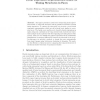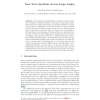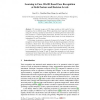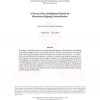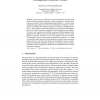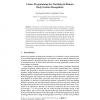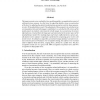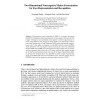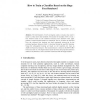100
Voted
AMFG
2005
IEEE
15 years 6 months ago
2005
IEEE
Abstract. This paper presents a method for interpreting facial expressions based on temporal structures among partial movements in facial image sequences. To extract the structures...
AMFG
2005
IEEE
15 years 6 months ago
2005
IEEE
Pose variations, especially large out-of-plane rotations, make face recognition a difficult problem. In this paper, we propose an algorithm that uses a single input image to accura...
113
click to vote
AMFG
2005
IEEE
15 years 6 months ago
2005
IEEE
2D intensity images and 3D shape models are both useful for face recognition, but in different ways. While algorithms have long been developed using 2D or 3D data, recently has see...
102
Voted
AMFG
2005
IEEE
15 years 6 months ago
2005
IEEE
We propose a simplified and practical computational technique for estimating directional lighting in uncalibrated images of faces in frontal pose. We show that this inverse probl...
124
click to vote
AMFG
2005
IEEE
15 years 6 months ago
2005
IEEE
We present a new framework to represent and analyze dynamic facial motions using a decomposable generative model. In this paper, we consider facial expressions which lie on a one d...
AMFG
2005
IEEE
15 years 6 months ago
2005
IEEE
We present a novel human body gesture recognition method using a linear programming based matching scheme. Instead of attempting to segment an object from the background, we develo...
120
Voted
AMFG
2005
IEEE
15 years 6 months ago
2005
IEEE
This paper presents a new method for face modeling and face recognition from a pair of calibrated stereo cameras. In a first step, the algorithm builds a stereo reconstruction of...
100
Voted
AMFG
2005
IEEE
15 years 6 months ago
2005
IEEE
Non-negative matrix factorization (NMF) is a recently developed method for finding parts-based representation of non-negative data such as face images. Although it has successfully...
AMFG
2005
IEEE
15 years 6 months ago
2005
IEEE
3D tracking of faces in video streams is a difficult problem that can be assisted with the use of a priori knowledge of the structure and appearance of the subject’s face at pred...
133
click to vote
AMFG
2005
IEEE
15 years 6 months ago
2005
IEEE
The development of web and digital camera nowadays has made it easier to collect more than hundreds of thousands of examples. How to train a face detector based on the collected en...
